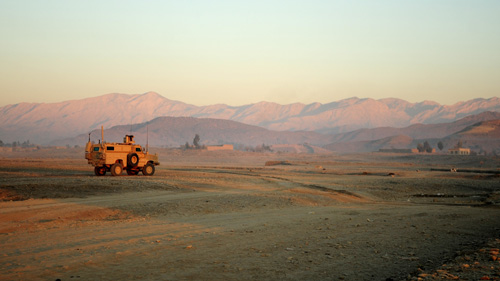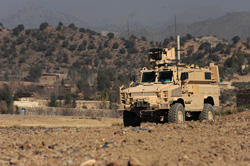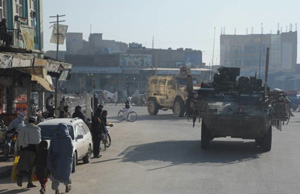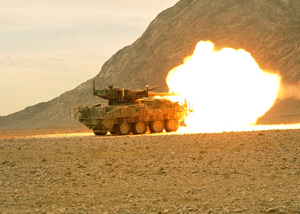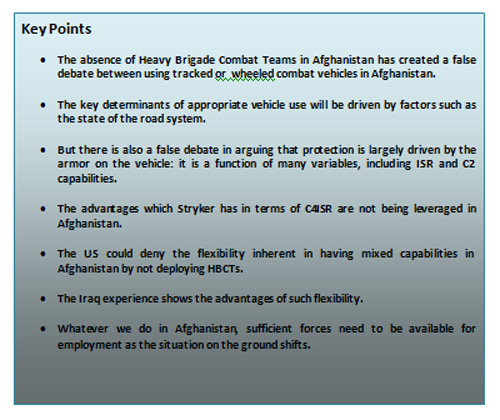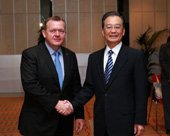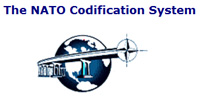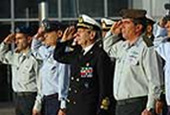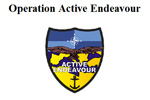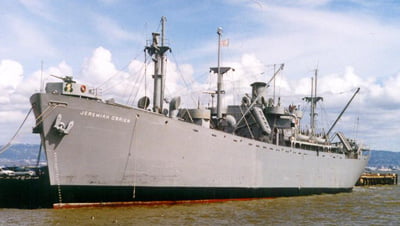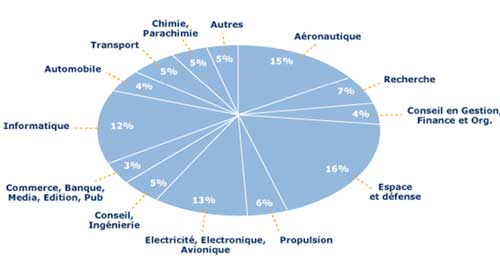Preparing for the F35: The 33rd Fighter Wing at Eglin Air Force Base Stands Up a Comprehensive Training Facility
Sldinfo’s Robbin Laird interviewed Colonel Tomassetti, 33rd Fighter Wing, Vice Commander, in early January 2010 and discussed the 33rd Fighter Wing’s approach to F-35 training and the nature of the training center.
SLDinfo: Let me start with the first, most obvious question: What is the 33rd Fighter Wing and what’s your role at the Wing?
Colonel Tomassetti: The 33rd Fighter Wing is the wing that has been charged with running the joint strike fighter, the F35 integrated training center operations here at Eglin Air Force Base. My role is I am the vice commander, so I answer to the wing commander, who is Colonel Dave Hlatky, United States Air Force. It is a joint organization. Key leadership roles are all made up from representatives from the three U.S. services, and they are on a rotation basis. They’re on separate timelines so that we don’t ever change out the entire leadership in any given rotation of military people in a summer.
SLD: The Wing is located at Eglin Air Force Base, and you are a Marine in a deputy commander role. What I was surprised to learn is that Eglin is not really just an Air Force base, but that you have several co-located military facilities on the base. This is collectively referred to as Team Eglin, so what are the advantages, from your point of view, of having the training center located in such a virtually joint setting?
Colonel Tomassetti: Eglin is a unique place. I’ve heard it said in several briefs since I’ve been here that if you count the land ranges and the over-water ranges that Eglin has purview over, it makes it the largest military base in the world. I’ve never verified that myself, but I would guess that’s a pretty accurate statement. There are a whole host of folks, who are tenants in that space here at Eglin, representatives from all the U.S. services and a variety of missions that go on here, everything from special forces to the training mission that we bring to the table in the 33rd Fighter Wing to the test mission that goes on for Air Force weapons testing, up to and including there is a phased array radar at one end of the complex that tracks space debris and is a national asset. So all that stuff is happening in the complex and with that wide variety of users that are present, in my mind from a training perspective for future air crew and maintainers, that presents us a wide variety of opportunities to interact with organizations, services, and capability that sometimes you have to wait for big exercises or even wars to bring to the table.
SLD: So you have a tremendous opportunity to leverage the co-located facility?
Colonel Tomassetti: Absolutely.
SLD: What is the basic timeline for rolling out the program this year and what might we expect to see in 2010?
Colonel Tomassetti: Our plan at the 33rd Fighter Wing is that we will be ready for training on 1 June of 2010 and what that means is we will start our first group of pilots in their first academic event on 1 June. The first group of pilots is here already and so that piece is ready. We are working through the courseware and the syllabus that they will be part of, so that piece is in work. We expect to have the simulators that they will train on delivered in the springtime, and we are expecting to have the airplanes that they will fly delivered in the fall. We have made provisions while construction is ongoing for the final facilities. If those facilities are not ready in time to accommodate all the hardware and stuff that’s coming in, that we have interim facilities planned. If they need to go into an interim classroom to start until the actual classrooms in the academic training center are available, we have provisions for that, so that’s our goal. We started training on 1 June here in the 33rd Fighter Wing with our first group of pilots and everything hopefully will flow in after that.
SLD: When are you anticipating a full ramp-up of the program and what kind of size student body would you have of maintainers and pilots in the program at that point?
Colonel Tomassetti: Actually if you look at the projections and again, right now, I’ll talk in terms of what will happen that will get us to capacity when we have three squadrons here at Eglin. The original vision was for five squadrons here at Eglin and some debate and some discussions and some decisions still remain on whether we will stay at three or whether we will grow to the planned five; but basically, around the 2014, 2015 timeframe, we will hit the peak pilot production based on three squadrons worth of airplanes. An average daily student load is the way we are tracking it, and is one of the metrics we’re tracking: how many students are on the campus on any given day. We expect somewhere between 80 and 100 pilot students on the campus on any given day; on the maintenance side, it will be a little slower to hit peak capacity. That comes around 2016 or so but we expect the average daily student load for maintainers to be somewhere between 600 and 800 on any given day. So really, you’re looking at almost 1,000 students on any given day here at the 33rd Fighter Wing.
SLD: I had a chance to look at some of the construction and got a sense of the layout of the new training center. It seems more like a college campus than a classic military training facility, and this would suggest that you have in mind several new approaches or techniques to operate in this center. Could you talk a little bit to those new approaches and techniques that you envisage to start with?
Colonel Tomassetti: it is indeed setup deliberately to have that sort of campus flavor and approach to it. The academic training center, the place where everyone will go through their classroom training and some of their initial simulator training, the living facilities for the enlisted folks and the dining facilities for those folks all sit in a very co-located area. No one has to cross any major roads to get from one building to another.
In fact, you could probably get everything you need to get done on any given day as a student without leaving that little four-block radius of space. We are going to take full advantage of everything that electronic classrooms of today bring to the table. That is everything from using a variety of electronic media; most everything that they will do in a classroom environment is computer-based training. Everybody whether you’re a pilot or maintainer will start out in those electronic classrooms, some of which are led by human instructors and some, which are purely computer-led, and computer-based training that they progress through. As an example, the pilots who check in here will be issued a laptop and that laptop, of course, will allow them to access information, words and pictures about the F35 that they are learning how to fly.
Additionally what it will do is it will allow them to practice some procedures that they will need in the cockpit. You can replicate some of the displays that appear in the cockpit of the airplane on that laptop. You can activate certain menus. You can drilldown through certain menus. You can work through certain procedures on that laptop up to and including if you check out the stick and throttle that can be connected to the laptop, you can actually go fly practice missions and practice profiles on that laptop. That can be done in the academic training center, and we’re working through what it would take for those pilot students to take that home and be able to practice at home at their own leisure for learning – – to continue their learning.
SLD: It would seem that the way you’ve set this up, there are a lot of savings to come from this approach compared to classic military training in the days of the F18 and F16 being the key programs.
Colonel Tomassetti: Absolutely. When I was a student going through initial flight training, I was issued a stack of books that not only did I have to carry those around with me in the classroom environment from day to day, but if I was going to take anything home, I had to drag that big bag of books home. Just taking all that stuff and putting it in a digital format and as you might be thinking, of course, not only you have access to whatever those books that are now digitized are but everything that’s ever been written or documented to that point in time about the F35 as far as technical information, with that laptop, those students will have access to it. So if they are particularly interested in a certain thing and the one page or the one paragraph in the flight manual didn’t fulfill their curiosity, they have the ability to dig down further into engineering drawings and background and stuff that I, as a student when I went through, never had the ability to go do.
SLD: Clearly this is setup to shape a joint approach to the training: from your point of view, how will this joint approach work out in terms of shaping the training and in reverse, the joint experience will shape training?
Colonel Tomassetti: You know, we’re going to be sitting here at Eglin Air Force Base. We’re going to have representatives from all three services in the U.S. and whatever partner countries are here at Eglin, and those students, without us doing anything deliberate or specific, are going to be going to the same classrooms, sitting next to each other. They’re going to go and they’re going to eat breakfast and lunch together in the same dining areas potentially. They’re going to go run in the same jogging rails. They’re going to go workout in the same fitness facilities.
So without even trying, there’s going to be an interchange of cultural ideas and philosophies. There’s going to be an interchange of how we do business, how they do business. There’s going to be an interchange of all kinds of basic information that those students will just naturally gravitate to as they’re exposed to being in close proximity to each other.
So that’s without even trying. Now if you say, “Okay, what if we put a little bit of effort and thought into that?” How much more could we get out of that where we deliberately setup training events that will make Navy, Marine, and Air Force pilots go fly training missions together as they get into their advanced studies where multiple airplanes are required and we allow them to share their ideas and their service techniques of doing things and then add in the partner countries that take part in this. The opportunity to learn and increase the knowledge base of everybody who comes through the Eglin campus is tremendous.
SLD: What’s the thinking about involving the partner countries?
Colonel Tomassetti: Right now, there will be partner countries at Eglin, those who are already involved in the program and then whatever foreign military sales happen as we go down range. Exactly how many and which partner countries will appear at Eglin has not quite been determined yet. There will be some. It could be up to and including everybody who’s in the program right now, and we are preparing and planning for it to be of that magnitude. If it’s something less than that, then so be it but right now, we are working towards being able to accommodate every partner country who is involved with the program today and even doing a little planning for all those anticipated foreign military sales that may come later on down the road.
SLD: You’ve co-located the training of maintainers and pilots and this seems almost unprecedented. What’s your sense of the importance of the co-location of the training of pilots and maintainers in the training center?
Colonel Tomassetti: I think training pilots and maintainers together is not unprecedented but by no means is it the common practice across the spectrum of JSF users. From my perspective, I think there are definitely going to be some efficiencies and some synergies gained from having the pilots and maintainers together. I mean they’re going to be integrated when they get to their operational units. Starting that integration out in the training environment is probably not a bad idea.
SLD: You have mentioned earlier that the program approach allows the sharing of resources within the program across the base, across Florida. Can you elaborate? Give me just, for example, a notional idea of, for example, you have a Navy pilot and he’s being trained in the program and has an opportunity to perhaps work with the Special Forces command, the Army command being transferred from Bragg. What’s your thinking about that kind of opportunity?
Colonel Tomassetti: Absolutely, and that goes back to your first question of: What are the opportunities that Eglin presents to us? You’re going to have young soldiers out on the land ranges here that are going through training in order to prep them to go forward to a combat area. Part of that training they’re going to do is going to involve working with air support. We are going to have students going through flight training who as part of the training they have to undergo is delivering that close air support to troops on the ground.
Now in most other places, if you’re at an air and a pilot training facility, you’ve got to call in to some other organization to come out and support you to do that kind of training for you’ve got to wait for some exercise to take place for that to happen. Here, we’re all going to be out on those ranges at the same day and instead of looking at it as a conflict where, hey, they want the range in the morning, we want the range in the afternoon, wouldn’t it be nice if we both went out on the range in the morning and that soldier on the ground got their training requirements accomplished because we were providing air support and our pilots in the airplanes got their training requirements accomplished because that soldier on the ground was doing their part of the close air support mission? I mean just things like that that will happen just because we’re sitting here. Again, it’s not even going to take a whole lot of effort on our part. All we’ve got to do is talk to each other to make it work.
SLD: So the joint training and the joint fighter go together with an opportunity to leverage the co-located facilities and the shared resources across those facilities.
Colonel Tomassetti: Absolutely and I think the other thing is we have an idea and a vision, of course, about what the F35 is in terms of its capabilities and how it will be employed on the battlefield. We have that vision today but until we get out there and actually use it we’re going to have to validate to that vision and our ideas of how we employ it are correct. But in this joint environment that we have here at Eglin, we may be able to come up with completely un-thought of ways of employing what the F35 can do into some future battle area just because we have a variety of players here that we will be able to get inputs from.
We will be able to test the airplane in terms of, “Hey, well, let’s expose it to this type of environment or to this situation that we haven’t thought about before.” I think that’s only going to come in a place like Eglin where we have the whole variety of users and folks out here that are trying to get their missions accomplished, their training accomplished all in the same location.
[slidepress gallery=’eglin’]
———-
***Posted January 24th, 2010



